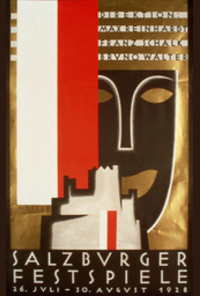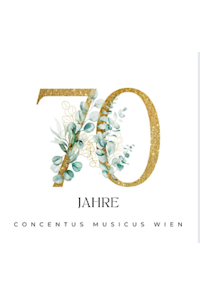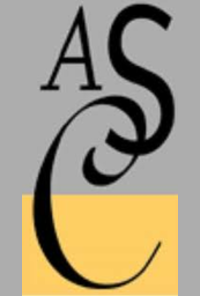Salzburg was once referred to as a “sacred city”. To a certain extent this is justified: for centuries the dominance of ecclesiastical power had a decisive impact on the character and appearance of the city. With inspired perception Max Reinhardt recognised the significance of this unique atmosphere when he decided to stage Hugo von Hofmannsthal’s Jedermann against the backdrop of the cathedral façade. The Salzburg Festival 2012 aims to follow on in this tradition by presenting for the first time a concert series of masterpieces of sacred music as a kind of “overture” to the main programme. Two performances of Jedermann are also integrated into this context. The primarily Christian content of the prologue is contrasted by a focus on Jewish music.
The series of concerts will be opened with a performance of Joseph Haydn’s oratorio The Creation dating from 1798. The work reflects how deeply impressed Haydn was by performances in London of the great oratorios by Handel. Haydn brought back from London an English text book about the story of the creation which Baron Gottfried van Swieten arranged for him for the musical composition. What is remarkable about the score are the immensely vivid portrayals of nature; however, of even greater significance is the florid melodic invention of the arias and ensembles, the hymnal splendour of the choruses.
The so-called Via Francigena is one of Europe’s oldest pilgrimage routes. It is the route taken by Sigeric the Serious, Archbishop of Canterbury, when, towards the end of the 10th century he walked the 1,700 kilometres to Rome. Sir John Eliot Gardiner and his Monteverdi Choir follow in his footsteps on a musical pilgrimage along which he intends to highlight the relationship between the architecture of major churches, monasteries and cathedrals with sacred vocal music from around 1450 to 1600. An arc will be spanned from Josquin Desprez to Jean Mouton, Clemens non Papa, Lassus and Palestrina to Claudio Monteverdi, and also includes English composers such as Tallis and Byrd.
Johann Sebastian Bach’s elaborate vocal polyphony led to the culmination of the golden age of the compositional genre of the a cappella motet; in particular in the Motet for double choir “Singet dem Herrn ein neues Lied” and “Komm, Jesu, komm!” Johann Christoph Bach, a distantly related uncle of the Thomaskantor, also devoted himself to the composition of motets. It is possible that he also wrote the Motet BWV Anh. 159 generally ascribed to Johann Sebastian Bach.
Masses by the genius loci Wolfgang Amadé Mozart feature prominently on the programme of the concert series. For the consecration of the Waisenhauskirche on the Rennweg in Vienna the twelve-year-old Mozart wrote a large-scale mass (K. 139) in the Viennese church style of that time, which he himself conducted in the presence of “her Imperial and Royal Majesty” on 7 December 1768 and which was received “with general applause and amazement”. In contrast the so-called Missa longa (K. 262), dating from 1776, follows the Salzburg tradition. Mozart obviously wanted to demonstrate his virtuosity in counterpoint with this work. This is true to an even greater degree for the Sacramental Litany, K. 243, dating from the same year with its rich use of concertante solo instruments and the daring polyphony of the final fugue. According to Salzburg tradition it was intended for the 40-hour long prayer that always began on Palm Sunday.
The culmination of Mozart’s creativity in this sphere is the magnificent torso of his Mass in C minor, K. 427, of which only the Kyrie, Gloria, Sanctus and Benedictus are written out completely. When Mozart visited Salzburg for the last time on 26 October 1783, he performed the Mass in St. Peter’s Abbey with his wife Constanze singing the first soprano solo role. Monumental movements for double choir in the style of Bach, a rousing Hallelujah paraphrase based on Handel, effective arias and ensemble movements in Italian style as well as masterful fugues characterise the work which in general has a retrospective structure. The programme of this concert also contains a work commissioned by the Salzburg Festival which Johannes Maria Staud (born in 1974) is in the process of writing; it is based on a text passage from Dante’s Divina Commedia. With his imaginative sense of sound Staud is one of the most interesting Austrian composers of the younger generation.
Intensive exploration of the text and striving for higher monumentality characterise the masses from the Romantic period, for instance Franz Schubert’s Mass in E-flat major, D. 950, dating from the year of his death, 1828. In the colourful treatment of the orchestra and the large-scale structure it creates a bridge from the masses of the Viennese Classical period to those by Anton Bruckner. The reduced instrumentation of Antonín Dvořák’s Mass in D major, written in 1887 – it uses only singing voices and the organ – does not stand in the way of impressive effects in sound and its large-scale exterior dimensions. It combines classical models with folk music-like melodies and true romantic harmonies.
In a wider sense Anton Bruckner’s Seventh Symphony also belongs here, especially as his symphonies have been characterised as “masses without words”. Completed in 1883, this work marked Bruckner’s final breakthrough as a composer. The Adagio, outlined as funeral music for Richard Wagner, contains sounds pointing forward to the Te Deum which was created the following year. In its powerful grandeur this composition is regarded as the most important musical setting of the early Christian hymn.
The Jewish focus in the concert series contains three works. Ernest Bloch (1880–1959), born in Switzerland, devoted about a third of his œuvre, which is dominated by romantic sound language, to Jewish themes. This also includes the work created between 1930 and 1933 entitled Avodath Hakodesh (Sacred Service) for baritone, choir and orchestra. In 1938 Arnold Schoenberg wrote Kol Nidre (literally “All vows”). From the traditional melodic formulae of a ceremony for the day of reconciliation Jom Kippur he created a melody which he embedded in a tonal context and dispensed with the twelve-tone system. It is preceded by a story about the dissemination of light in the world by God. The most recent work in this group is the Symphony written in 1985, Mechaye Hametim (Awakening of the Dead), by Noam Sheriff who was born in 1935. It is written for soloists, two choruses and orchestra and is based on traditional Jewish music of Eastern Europe as well as on ancient oriental and Jewish themes.
Finally, the sphere of music-theatre features the sacred singspiel Die Schuldigkeit des ersten Gebots, the first part of which “little Mozart” set to music in 1767. As the two other parts, composed by the Salzburg musicians Cajetan Adlgasser and Michael Haydn, are lost, the story has an open ending: Christianity and Worldliness fight for the soul of the “lukewarm Christian”. It’s hardly surprising that the prevailing tone of the music by the eleven-year-old Mozart is cheerful and playful.



